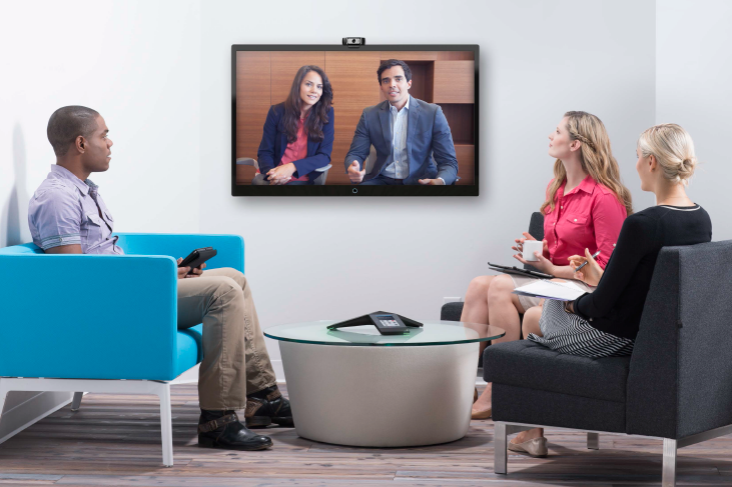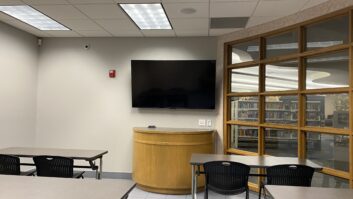
Having previously looked at what is driving the growing demand for huddle rooms, before addressing the new set of considerations this presents to integrators, Ian McMurray concludes by revealing the size of the potential opportunity and considering the impact this will have on traditional meeting rooms.
For those not already addressing the market, is there a worthwhile opportunity?
“For Kramer, huddle spaces have become one of our top installations by a long shot,” says Michael DiBella, director – collaborative solutions at Kramer Electronics USA. “We have a diverse product portfolio that can accommodate installations like this, led by our VIA wireless collaboration solution. Integrators are unquestionably making money by taking advantage of the growth in huddle spaces. Those spaces are going to be the standard room installation for a long time to come.”
Stuart Carter, installation technology manager at UK integrator Saville is no less enthused.
“We are seeing increasing demand especially on larger projects, across all verticals and especially in the corporate and higher education sectors,” he notes. “I think the demand will increase as organisations see the benefit in turning communal spaces into valuable meeting room areas, and thereby making informal meetings more opportunistic. Booking a particular meeting room just to have an informal review of a few slides or perhaps a brainstorming session can kill the flow before it has even started. The modern generation of instant screen sharing combined with an attractive and more relaxed environment is more appealing, easier to use and can be the catalyst to sharing, creating and capturing ideas.”
For many integrators, meeting rooms have long been an important market. However: there must be some trepidation that all-singing, all-dancing conference rooms and boardrooms will give way to much smaller, much less expensive facilities – even if there will likely be many more of them. Are those fears founded?
“There’s a trend towards more rooms in the enterprise, with the ratio between huddle rooms and traditional meeting rooms changing in favour of the former,” believes Lieven Bertier, global marketing manager, collaboration at Barco.
It is, of course, easy to think of huddle rooms as purely a large corporate phenomenon – but, in fact, as Wolfgang Haunschild, product marketing manager at NEC Display Solutions Europe points out, it’s possible to think of them also as mainstream meeting rooms appropriate for smaller companies.
“According to Futuresource, over 50% of all the meeting rooms in Europe are located in small- and micro-sized companies,” he says, “and 45% of those rooms are for six or fewer people. The research says that, while there will be 8% growth in meeting rooms over the next three years, the number of interactive displays deployed in meeting rooms will increase by 30% – a strong indication of the rapid movement towards the collaborative meetings that huddle rooms enable.”
Continuing significance
Marco Landi, president, EMEA at Polycom has a similar view, both in terms of the continuing significance of traditional meeting spaces and in terms of the opportunity that exists with smaller organisations.
“The rise of huddle rooms does not necessarily mean that there will be a decline in demand for other meeting or conferencing rooms,” he explains. “However, smaller businesses generally don’t have the space or budget to install a big videoconferencing environment, so the market has adapted and created solutions that help SMEs access the productivity and efficiency gains that were historically limited to large enterprises.”
“What’s happening does not mean a major decline in ‘normal’ meeting rooms,” says Carter, “as they will always be needed for the larger more formal meetings that have presentations or are designed for specific uses such as videoconferencing. The emergence of the huddle zone will help free up these meeting rooms for the more important meetings. Meeting room space is at a premium and they are always very heavily booked especially in a busy corporate world.”
“We have worked on huddle rooms in many small to medium-sized business, as well as enterprise-level companies,” adds Brady O Bruce, chief marketing officer at InFocus.
It looks, then, as if the huddle room is an almost entirely incremental opportunity for the AV industry – manufacturers and integrators alike – and one that exists across all types of organisation and discipline.
Transcending verticals
“All markets embrace the huddle space,” concludes DiBella. “Creative departments such as marketing, sales and HR were among the early adopters who became the key drivers for this kind of flexible space. But: based on its success and low investment, we’re seeing it spread to more conservative departments like accounting. Huddle rooms transcend verticals. It won’t be long till millennials comprise more than 50% of the workforce. Regardless of job function or vertical, this is how they meet – and spaces will be built to accommodate their preferences.”
Despite the cynicism of some who believe the huddle room phenomenon is some kind of marketing construct, fiendishly devised by manufacturers in order to expand the available opportunity, it becomes clear that nothing could be further from the truth. Everything about the concept of huddle rooms hangs together – from the changing physical nature of office space to the rise of the millennial as a force in corporate culture, from the increasing corporate emphasis on flexibility and agility to the growing focus on collaboration as a way of working. Yes, AV technology has responded – is responding – to the opportunity, but it didn’t create it. Huddle rooms are the real deal, and likely to be a significant factor in the AV industry for some time to come.
www.barco.com
www.infocus.com
www.kramerav.com
www.nec-display-solutions.com
www.polycom.com
www.saville-av.com







